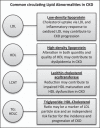Systemic and renal lipids in kidney disease development and progression
- PMID: 26697982
- PMCID: PMC4971889
- DOI: 10.1152/ajprenal.00375.2015
Systemic and renal lipids in kidney disease development and progression
Abstract
Altered lipid metabolism characterizes proteinuria and chronic kidney diseases. While it is thought that dyslipidemia is a consequence of kidney disease, a large body of clinical and experimental studies support that altered lipid metabolism may contribute to the pathogenesis and progression of kidney disease. In fact, accumulation of renal lipids has been observed in several conditions of genetic and nongenetic origins, linking local fat to the pathogenesis of kidney disease. Statins, which target cholesterol synthesis, have not been proven beneficial to slow the progression of chronic kidney disease. Therefore, other therapeutic strategies to reduce cholesterol accumulation in peripheral organs, such as the kidney, warrant further investigation. Recent advances in the understanding of the biology of high-density lipoprotein (HDL) have revealed that functional HDL, rather than total HDL per se, may protect from both cardiovascular and kidney diseases, strongly supporting a role for altered cholesterol efflux in the pathogenesis of kidney disease. Although the underlying pathophysiological mechanisms responsible for lipid-induced renal damage have yet to be uncovered, several studies suggest novel mechanisms by which cholesterol, free fatty acids, and sphingolipids may affect glomerular and tubular cell function. This review will focus on the clinical and experimental evidence supporting a causative role of lipids in the pathogenesis of proteinuria and kidney disease, with a primary focus on podocytes.
Keywords: cholesterol; dyslipidemia; kidney disease; lipids; podocytes.
Copyright © 2016 the American Physiological Society.
Figures


Similar articles
-
Lipotoxicity and impaired high density lipoprotein-mediated reverse cholesterol transport in chronic kidney disease.J Ren Nutr. 2010 Sep;20(5 Suppl):S35-43. doi: 10.1053/j.jrn.2010.05.010. J Ren Nutr. 2010. PMID: 20797569 Review.
-
Relation of serum lipids and lipoproteins with progression of CKD: The CRIC study.Clin J Am Soc Nephrol. 2014 Jul;9(7):1190-8. doi: 10.2215/CJN.09320913. Epub 2014 May 15. Clin J Am Soc Nephrol. 2014. PMID: 24832097 Free PMC article.
-
High lipid levels in very low density lipoprotein and intermediate density lipoprotein may cause proteinuria and glomerulosclerosis in aging female analbuminemic rats.Lab Invest. 1995 Dec;73(6):912-21. Lab Invest. 1995. PMID: 8558854
-
Change in Dyslipidemia with Declining Glomerular Filtration Rate and Increasing Proteinuria in Children with CKD.Clin J Am Soc Nephrol. 2019 Dec 6;14(12):1711-1718. doi: 10.2215/CJN.03110319. Epub 2019 Nov 11. Clin J Am Soc Nephrol. 2019. PMID: 31712386 Free PMC article.
-
Disorders of lipid metabolism in nephrotic syndrome: mechanisms and consequences.Kidney Int. 2016 Jul;90(1):41-52. doi: 10.1016/j.kint.2016.02.026. Epub 2016 Apr 26. Kidney Int. 2016. PMID: 27165836 Free PMC article. Review.
Cited by
-
Reversal of hypertriglyceridemia in diabetic BTBR ob/ob mice does not prevent nephropathy.Lab Invest. 2021 Jul;101(7):935-941. doi: 10.1038/s41374-021-00592-8. Epub 2021 Apr 28. Lab Invest. 2021. PMID: 33911188 Free PMC article.
-
An investigation of low-protein diets' qualification rates and an analysis of their short-term effects for patients with CKD stages 3-5: a single-center retrospective cohort study from China.Int Urol Nephrol. 2023 Apr;55(4):1059-1070. doi: 10.1007/s11255-022-03390-3. Epub 2022 Oct 31. Int Urol Nephrol. 2023. PMID: 36310191 Free PMC article.
-
Lipidomic study of kidney in a mouse model with urine flow obstruction.Sci Rep. 2024 Aug 5;14(1):18042. doi: 10.1038/s41598-024-68270-5. Sci Rep. 2024. PMID: 39098953 Free PMC article.
-
From Adipose to Ailing Kidneys: The Role of Lipid Metabolism in Obesity-Related Chronic Kidney Disease.Antioxidants (Basel). 2024 Dec 16;13(12):1540. doi: 10.3390/antiox13121540. Antioxidants (Basel). 2024. PMID: 39765868 Free PMC article. Review.
-
Association between uric acid to high-density lipoprotein cholesterol ratio and chronic kidney disease among Chinese middle-aged and older adults with abnormal glucose metabolism: a nationwide cohort study.Int Urol Nephrol. 2025 Apr;57(4):1297-1309. doi: 10.1007/s11255-024-04308-x. Epub 2024 Dec 2. Int Urol Nephrol. 2025. PMID: 39623196
References
-
- ADVANCE Study Investigators. Rationale and design of the ADVANCE study: a randomised trial of blood pressure lowering and intensive glucose control in high-risk individuals with type 2 diabetes mellitus. Action in Diabetes and Vascular Disease: PreterAx and DiamicroN Modified-Release Controlled Evaluation. J Hypertens Suppl 19: S21–28, 2001. - PubMed
-
- Agarwal R. Effects of statins on renal function. Am J Cardiol 97: 748–755, 2006. - PubMed
-
- AIM-HIGH Investigators AH, Boden WE, Probstfield JL, Anderson T, Chaitman BR, Desvignes-Nickens P, Koprowicz K, McBride R, Teo K, Weintraub W. Niacin in patients with low HDL cholesterol levels receiving intensive statin therapy. N Engl J Med 365: 2255–2267, 2011. - PubMed
-
- Aron-Wisnewsky J, Minville C, Tordjman J, Levy P, Bouillot JL, Basdevant A, Bedossa P, Clement K, Pepin JL. Chronic intermittent hypoxia is a major trigger for non-alcoholic fatty liver disease in morbid obese. J Hepatol 56: 225–233, 2011. - PubMed
Publication types
MeSH terms
Substances
Grants and funding
- DK-090316/DK/NIDDK NIH HHS/United States
- U24 DK076169/DK/NIDDK NIH HHS/United States
- U54DK-083912/DK/NIDDK NIH HHS/United States
- U54 DK083912/DK/NIDDK NIH HHS/United States
- R01 DK104753/DK/NIDDK NIH HHS/United States
- UM1 DK100846/DK/NIDDK NIH HHS/United States
- UL1 TR000460/TR/NCATS NIH HHS/United States
- R56 DK104753/DK/NIDDK NIH HHS/United States
- UM1DK-100846/DK/NIDDK NIH HHS/United States
- UL1TR-000460/TR/NCATS NIH HHS/United States
- R01 DK090316/DK/NIDDK NIH HHS/United States
- U24DK-076169/DK/NIDDK NIH HHS/United States
- DK-104753/DK/NIDDK NIH HHS/United States
LinkOut - more resources
Full Text Sources
Other Literature Sources
Medical

